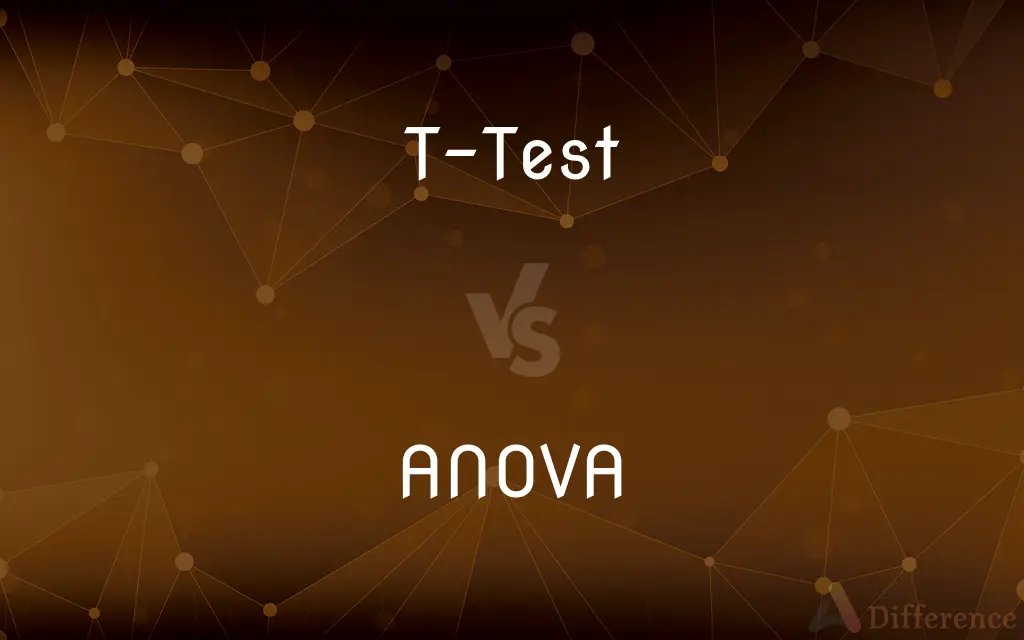T-Test vs. ANOVA — What's the Difference?
By Tayyaba Rehman — Published on December 20, 2023
T-Test compares means of two groups; ANOVA compares means of three or more groups.

Difference Between T-Test and ANOVA
Table of Contents
ADVERTISEMENT
Key Differences
A T-Test is a statistical test that is used to compare the means of two groups and determine if the differences between them are statistically significant. In contrast, ANOVA, which stands for Analysis of Variance, is a method that compares the means of three or more groups. Both the T-Test and ANOVA are valuable tools in hypothesis testing and research analysis.
The T-Test is often employed when researchers have data from two groups and want to determine if there is a significant difference between them. On the other hand, ANOVA is used when the study involves more than two groups. While the T-Test provides a direct comparison between two sets, ANOVA provides a more holistic view when multiple groups are in the picture.
It's essential to note that while the T-Test is restricted to comparing just two groups, ANOVA has no such limitation. However, a key similarity between the T-Test and ANOVA is that both are parametric tests, meaning they assume the data follows a specific distribution, usually the normal distribution.
Another difference between the T-Test and ANOVA is the way they handle Type I errors. With multiple T-Tests, the risk of committing a Type I error increases with each additional test. ANOVA, by contrast, handles multiple comparisons without inflating the Type I error rate.
In essence, while both T-Test and ANOVA are methods to compare means and determine statistical significance, their applications and mechanisms differ based on the number of groups involved in the comparison.
ADVERTISEMENT
Comparison Chart
Number of Groups
Two
Three or more
Purpose
Compare means of two groups
Compare means of multiple groups
Type I Error Management
Increases with multiple tests
Handles multiple comparisons without increasing error rate
Assumption
Parametric test
Parametric test
Example
Comparing scores of males vs. females
Comparing scores across four different teaching methods
Compare with Definitions
T-Test
Tests hypotheses about two population means.
The T-Test showed no significant difference in heights between two species of plants.
ANOVA
Compares the means of three or more groups.
ANOVA was employed to determine if there were performance differences across five age groups.
T-Test
Compares the means of two groups.
A T-Test was conducted to evaluate performance differences between male and female students.
ANOVA
Tests if group means differ significantly from each other.
ANOVA revealed that different instructors had a significant impact on student grades.
T-Test
Statistical method to determine if two groups differ significantly.
The T-Test results indicated a significant difference in scores between the two teaching methods.
ANOVA
Statistical analysis for multiple group comparisons.
Using ANOVA, we found significant variations in results among the four different treatments.
T-Test
Assesses if the means of two groups are likely from the same population.
The T-Test suggested that the two sample groups were likely drawn from different populations.
ANOVA
Evaluates variance among and between groups.
Through ANOVA, it was clear that there was greater variance between groups than within them.
T-Test
Examines if two group averages are statistically different.
We used a T-Test to check if brand A's satisfaction rate differed from brand B's.
ANOVA
Examines multiple group variances to identify differences.
ANOVA was used to identify which departments had differing sales figures.
T-Test
(statistics) Student's t-test
ANOVA
A statistical method for making simultaneous comparisons between two or more means; a statistical method that yields values that can be tested to determine whether a significant relation exists between variables
Common Curiosities
How does ANOVA differ from a T-Test?
ANOVA compares the means of three or more groups, while a T-Test is limited to two.
What is the primary application of a T-Test?
The T-Test is used to compare the means of two groups.
Are there assumptions for both T-Test and ANOVA?
Yes, both assume the data follows a normal distribution and other parametric assumptions.
When should I choose T-Test over ANOVA?
Choose T-Test when you are comparing the means of just two groups.
Why is ANOVA better for multiple group comparisons?
ANOVA can handle multiple group comparisons without inflating the Type I error rate.
Is the output of ANOVA more detailed than a T-Test?
Generally, yes, because ANOVA tests variance both within and between groups.
Why might one use ANOVA instead of multiple T-Tests?
Using multiple T-Tests increases the risk of Type I errors, which ANOVA can manage.
Which is more robust against violations of assumptions, T-Test or ANOVA?
Both require their assumptions to be met for valid results, but certain types of ANOVAs can be more robust.
What are the types of ANOVA?
There are several, including One-Way, Two-Way, and Repeated Measures ANOVA.
How does sample size impact T-Test and ANOVA?
Both tests are sensitive to sample size, which can influence the power and significance of the test.
Can I use a T-Test for three groups?
No, for three or more groups, ANOVA is appropriate.
Are T-Test and ANOVA used for categorical data?
No, both are used for continuous data with categorical independent variables.
Can I follow up ANOVA with a T-Test?
Yes, if ANOVA indicates a significant difference, post-hoc T-Tests can pinpoint where the differences lie.
Can both T-Test and ANOVA be used for paired data?
Yes, there are paired versions of both the T-Test and ANOVA.
How is the significance level determined in T-Test and ANOVA?
Typically, a p-value less than 0.05 is considered significant in both tests, though this threshold can vary.
Share Your Discovery

Previous Comparison
Emphasis vs. Emphasize
Next Comparison
Maestro Card vs. MasterCardAuthor Spotlight
Written by
Tayyaba RehmanTayyaba Rehman is a distinguished writer, currently serving as a primary contributor to askdifference.com. As a researcher in semantics and etymology, Tayyaba's passion for the complexity of languages and their distinctions has found a perfect home on the platform. Tayyaba delves into the intricacies of language, distinguishing between commonly confused words and phrases, thereby providing clarity for readers worldwide.















































